COLLEGE FOOTBALL 25 DYNASTY DEEP DIVE

Welcome Back to the Campus Huddle, your home for news and information about EA SPORTS™ College Football 25!
We know you have been awaiting more information about the fan favorite Dynasty Mode. Before we get started with the Campus Huddle, let's hear from Kirk Herbstreit for a video deep dive on Dynasty Mode.
After, you’ll hear from Chad Walker, Producer, and Ben Haumiller, Principal Game Designer, for College Football 25. Let’s get started!
BUILDING DYNASTY
When we were in the early stages of designing Dynasty Mode, we talked with members of the community, college football experts and coaches, read hundreds of blog posts and tweets, and watched countless wishlist videos. We knew how important Dynasty was to our community and we heard loud and clear that our players wanted a deep experience that is representative of the current college football landscape where roster management and talent acquisition are at the forefront of successful programs.
With this in mind, we anchored our experience around three core pillars: “Build Your Coach”, “Build Your Program”, and “Deliver the World of College Football”.
- Build Your Coach: This encompasses the decisions you make on your coaching journey to the top of the college football world. Whether that’s starting as a coordinator at a small school and making a name for yourself before getting that first head coaching job, or starting as a head coach at your dream school. Every decision you make on your journey matters.
- Build Your Program: As the old saying goes, “to win in College Football it’s not the X’s and the O’s, it’s the Jimmy’s and the Joe’s”. Recruiting is the lifeblood of College Football and having a consistent winner means you need a roster that is built to reload rather than rebuild. That all starts on the high school recruiting trail, but in modern College Football roster retention and utilizing the Transfer Portal are instrumental in your ability to field a championship team.
- Deliver the World of College Football: A lot has changed in college football over the last year, let alone the last 11 years. From the new 12 team College Football Playoff to conference realignment, we set out to recreate the ever-changing world of college football within Dynasty and provide you with the tools to customize your experience.
Underlying our three core pillars was one singular motto: “Satisfy the Core Community” because “This is THEIR game”.

BUILD YOUR COACH
Your journey to the top of the college football world starts with your coach. We wanted this to be meaningful and allow you to experience the coaching journey that no other sport can provide. We met with college football coaches and experts and started breaking down real life coaches on the whiteboard. What was their identity? What made them great? What was their journey to get to where they are today?
What we found was that both current and former coaches broadly fit into three main categories. Some are incredible recruiters, while others are motivators who maximize the potential of their players, and lastly tacticians out-scheme their opponents with on-field X’s and O’s.
There were also a number of coaches who were more of a hybrid between two categories. For example, there were coaches who were great at both recruiting and X’s and O’s. After breaking down hundreds of coaches, two things were loud and clear: no coach was great at everything and there is no single path to being a great coach.
What about the greatest coaches of all time? Even they weren’t great at everything and needed their coordinators. Let’s look back to 2013. Alabama’s offense had fallen behind. The world of college football offenses was changing and it was changing quickly. They had to pivot and change their entire philosophy, bringing in an offensive guru who transformed the Alabama offense and put the program on an entirely new trajectory playing in 6 of the next 8 national championships while creating multiple first round drafted quarterbacks.
All of our research and discussions led us to build a coach experience centered around three goals:
- Just like the real world, no coach could be great at everything.
- A rock, paper, and scissors relationship between coach types with no dominant progression path.
- Coordinators and how you build your staff matter.
COACH PROGRESSION
Progressing your coach starts with playing games. As you play, you will complete coach goals that award XP. Once you earn enough XP, you will level up your coach (to a maximum of level 50) and be awarded Coach Points. Coach Points can be used to upgrade your coach’s abilities (more on that later).
There are four Coach XP Goal categories that can be single game, weekly, season, or career goals.
- Draft: Pro draft goals based on which round your player is drafted in, for example “Player Drafted in the 1st Round”.
- Game: Individual game goals that range from a single play result like “Interception” and “Rushing Touchdown” to a full game result. For example, “Beat Your Rival”, “Beat a Top 25 Team”, and “Win a National Championship”.
- Recruiting: Determined by your success on the recruiting trail. Recruiting goals can be specific to a single prospect, for example “Sign a 5 Star Prospect” or a full season like “Sign the Best Recruiting Class in the Country”.
- Stats: Weekly goals like “Ranked in the Top 10”, season stat goals for example “4,000 Team Passing Yards” and “Rank Top 5 in Offensive Yards”, and career goals like “Win 5 National Championships”.
The number of times you’ve completed a goal and your progress towards goal completion can be viewed in the Coach XP Goals screen, which can be accessed via the Coach tab in the Dynasty Hub. We have also added five progression speed settings, so you can modify how fast coaches progress in your Dynasty.
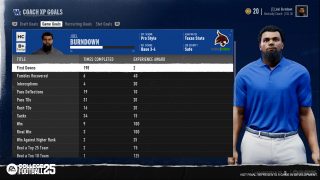
Each time you complete a goal in-game, you will receive a notification in the top left corner of the screen. The notification will describe the completed goal and XP reward.
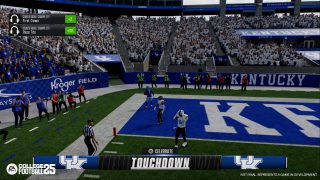
After completing a game or advancing the week, you will receive an XP summary screen showing your progression to the next level.
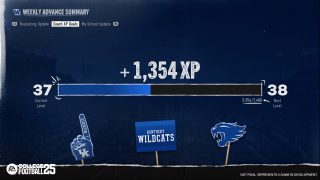
COACH ARCHETYPES
In EA SPORTS College Football 25, we are introducing a new archetype based coach abilities system. You can think of this similar to your traditional RPG classes where all of your party members have a specific class (archetype) and role. Ultimately, in order for your team to be successful, all of the players in your party must do their job and work together.
Our system is no different. All coaches will start with a base class or coach archetype, which can be thought of as your special ability in a traditional RPG. Just like our real life coaches, the base archetypes fall into three categories: Recruiting, Motivation (think player development and program culture), and Scheme (on field X’s and O’s).
From your base archetype, you can progress in multiple ways. You can become an expert in a single category like recruiting where you become an Elite Recruiter and excel on the recruiting trail. Alternatively, you can become a hybrid coach who is strong in multiple areas. For example, a Talent Developer who is great at both talent acquisition (Recruiting) and player development (Motivation). The ultimate goal is to become a Program Builder or CEO atop the world of college football.
Achieving an elite archetype like Program Builder or CEO is a combination of on-field success and ability progression. There is no single formula to reach these statuses. You will be able to mix and match different ability combinations and progression paths, leading to strong customization.
In total, there are 11 different archetypes each with their own focuses and perks. Together, they form a rock, paper, and scissors relationship where there is no dominant archetype. While there is no doubt that talent acquisition is the most important thing in college football, focusing solely on recruiting could leave you vulnerable in other areas. Remember, no coach can be great at everything. Every decision you make on your coaching journey matters. Once you purchase an ability, there is no going back as you will not be able to re-spec your coach.
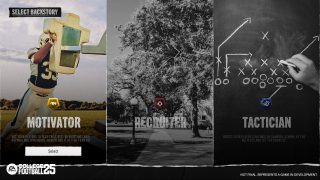
How Do I Upgrade My Archetype and What Does it Do?
Each archetype has a set of prerequisites and objectives that must be completed in order to purchase them. For example, in order to become an Elite Recruiter, you must spend 50 Coach Points in the Recruiter archetype and sign two top five recruiting classes. Once these goals are complete, the archetype becomes available for purchase with coach points. When creating your coach, you will select which base archetype you want to start with. The other two base archetypes will then be available for purchase with coach points without the need to meet any additional requirements.
Purchasing an archetype with coach points unlocks new sets of abilities, as well as new opportunities in the coaching carousel (more on that later). Additionally, each archetype has a perk when it is active. For example, Tactician has the Winner perk, which awards additional coach XP every time you win a game.
Your active archetype is automatically determined. If you own the Program Builder or CEO archetypes, they will always be your active archetype regardless of how many coach points you’ve spent in other archetypes. If you do not own these archetypes, your active archetype is the archetype you have spent the most coach points in. All owned coach abilities are always on, regardless of which archetype is currently active.
Your progress can be viewed in the Coach Abilities screen, which is accessible from the Coach tab of the Dynasty Hub. Within the screen, you can see all of the available archetypes, their unlock requirements and perks, and your overall progression in each archetype. As you spend coach points in each archetype, the spider graph in the center of the screen will morph and change to show your coach’s DNA.

How Do the Abilities Work?
Once you own an archetype, you can purchase the abilities within it using coach points. In College Football 25, we are introducing more than 50 coach abilities. Each ability can have up to four tiers and every tier has a purchase cost associated with it. Every archetype, with the exception of Scheme Guru, Program Builder, and CEO, has their abilities broken down by position group. This increases the level of depth and specialization each coach has.
No longer is a coach great at recruiting across the board. Now, coaches will specialize in specific position groups – making your staff composition that much more important. Are you a quarterback whisperer? Are you great in the trenches and committed to the no fly zone? How does your staff complement you?
In addition to position based boosts, there are also coach abilities with core gameplay effects so you can really cook. For example, the Scheme Guru archetype focuses on your gameplay style. If you are a coach who likes to play fast, you can upgrade Fast Tempo Offense providing you with the following boosts:
- Battery Pack (Tier 1): Offensive players fatigue slower in hurry up
- Caught Napping (Tier 2): Increase delay to defenders looking to the sideline at the snap
- On Their Heels (Tier 3): Team composure boost for 1st downs gained while running hurry up
- Tipped Your Hand (Tier 4): Chance to see the defense’s coverage shell in hurry up
You can also make your team a well oiled machine who doesn’t work against themselves and is unfazed by rowdy homefield crowds by upgrading the Discipline/Communication ability. On offense this provides:
- Hater Blockers (Tier 1): Slight reduction in crowd noise impact on the road
- Teflon (Tier 2): Significant reduction of crowd noise impact on the road
- Polished (Tier 3): Offensive players will commit slightly fewer penalties
- Clean Sheet Offense (Tier 4): Offensive players will commit significantly fewer penalties
Of course, balance is critically important here so there are defensive counters to ALL of the offensive play style abilities. Is your defense looking a little sus or are you tired of getting punched in the mouth by a physical ground and pound team? Upgrade your Ground and Pound defense to become a stout run defense and reduce the effects of a physical offense continuously running the football.
The Program Builder and CEO archetypes are different in that they are only available to head coaches. The abilities within them are diverse and range from roster management and program culture to home field advantage and recruiting pipeline boosts.
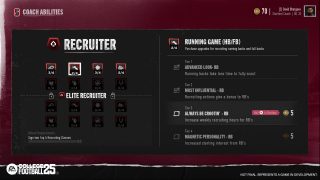
What About Coordinators?
Both coordinators and head coaches have the same set of abilities and archetypes available to them leading to a natural progression from coordinator to head coach and increased importance on staff management where your coordinators either compliment your strengths or shore up your deficiencies. Remember, no coach can be great at everything, so it is critical that your coordinators compliment you.
All of the abilities your coaching staff own stack together, increasing the effect of an ability. Abilities owned by the head coach have the greatest impact. The impact of coordinator owned abilities depends on whether or not the ability is related to their side of the ball. For example, a defensive coordinator having the Quarterback Icy Veins ability, which boosts your quarterback’s composure at the beginning of the game, will have a much smaller effect than an offensive coordinator owning it.
Your coordinators will automatically progress their archetypes and abilities. You will not be able to control which abilities they purchase nor will you be able to re-spec your coordinator’s abilities. This adds even more importance to how you progress your coach and manage your staff in the coaching carousel.
You can view the abilities your coordinators own from within the Coach Abilities screen by tabbing left and right with LB/RB or L1/R1. Each coach will have a unique spider graph based on the abilities and archetypes they own. Pressing R3 will overlay all of three coach’s spider graphs, so you can quickly see where your staff is deficient.
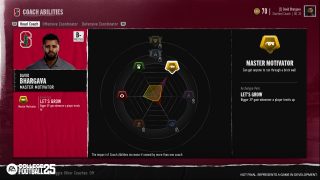
CLIMBING THE COACHING LADDER
Your journey starts when you sign your first coach contract. When creating your Dynasty, you will have the option to select whether you want to be a head coach, offensive coordinator, or defensive coordinator. Coordinators have performance expectations just like a head coach. All roles will have full control of recruiting and be able to play both sides of the ball during gameplay.
Sign here, please
Every time you start a new coaching job, you’ll be asked to sign a contract with that school. The contract will have a set contract length and performance expectations. Just like in real life, failure to meet those expectations will result in bad things happening.
School expectations are determined by the school’s current team prestige and program standing. The better the school, the higher the expectations. There are four types of contract expectations:
- Win (X) Games
- Win a Conference Championship
- Make the College Football Playoff
- Win a National Championship
Your job security will fluctuate throughout the season based on the results of your games and whether or not you are trending towards meeting your contract expectations. The further you are from meeting your expectations, the bigger your job security will be hit. If your job security gets too low, you will end up on the hot seat and if your seat gets too hot, you’ll be fired and have to look for a new job in the coaching carousel. Alternatively, meeting or exceeding your goal will result in increased job security. Of course, if you don’t like the possibility of being fired, you can always turn off user coach firing in your Dynasty settings.
Job security is a function of your ability to meet your contract expectations. Every win and loss counts towards that expectation. With that being said, not all wins and losses are created equal. Beating a higher ranked team will have a larger impact than beating one of the generic FCS teams. Similarly, losing to a generic FCS team is not a good look.
All coaches also have a coach prestige letter grade that ranges from A+ to F. Coach prestige is reflective of your ability to meet contract expectations, adjusted for the school and role that you have. For example, meeting expectations and winning five games at a small school will have a significantly smaller impact than winning the SEC championship at a traditional powerhouse school.
At the end of your contract, the school will evaluate whether or not they want to extend your contract based on your performance. If you are offered an extension, you will be notified that the school has decided to extend your contract and it will be automatically accepted. Don’t worry, automatic acceptance of contract extensions does not mean that you are unable to change jobs. You can leave for a new job via the coaching carousel at any point in your contract, regardless of your current contract status. We auto accept extensions to protect you from inadvertently changing jobs if you sim past a contract extension offer without interacting with it.
Your current coach contract and job security status can be accessed from the Coach tab of the Dynasty Hub. When viewing your contract, you can see your current and past season job security, contract expectation, and your school’s season by season results for the last 20 years. The season by season results show the team’s record, if they were a conference champion, and any bowl games they won in that season.
When signing your contract, you’ll have the opportunity to look at the last 20 years and see the kind of program you are taking over. Of course, your program’s history will continue to update over time as you play your dynasty.
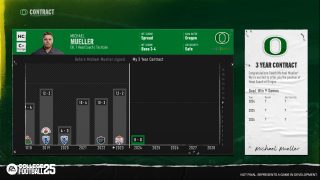
COACH CAROUSEL
Following the 2021-2022 college football regular season, two high profile schools in LSU and USC were looking for new coaches. Both schools did what nobody saw coming and hired elite coaches from other high profile schools. Suddenly, other high profile jobs were unexpectedly available and the coaching carousel was in full effect.
In College Football 25, we set out to recreate the chaos that is the college football coaching carousel, along with the domino effect it brings. Now, instead of happening over a single week, the coaching carousel takes place over the course of five weeks from conference championship week to the end of bowl season, just like the real world. Additionally, the carousel is now an asynchronous experience where each user can evaluate their offers without the need to wait on someone else. That way in your multi-user Online Dynasty, the entire carousel experience won’t be held up because you are sitting around waiting for your friend to get on and evaluate their job offer only for them to tell you they want to stay at their current job.
How Does the Coach Carousel Work?
The carousel kicks off during Conference Championship week. During this week, all coach contracts are processed and schools determine if they want to fire, extend, or let a coach’s contract expire. If your school has decided to fire or extend you, you’ll receive an action item notifying you of the news. If you are the head coach, you’ll also be able to fire your coordinators during this week (more on that later).
Once you advance the week and arrive in bowl season, the first round of job offers go out. If you received any job offers, you will be notified via an action item titled “View Job Offers”. If you did not receive any offers, you will have a generic action item titled “Coach Carousel”. Pressing the action item will take you to the coach carousel screen where you can view any job offers you have, as well as all of the open jobs around the country.
Just because you didn’t receive any offers in the first week of bowl season or if you didn’t like the offers you received, doesn’t mean your carousel experience is over. Remember, the coach carousel takes place over the course of multiple weeks. The first week of bowl season is just the beginning. As schools hire and poach coaches from other schools, their previous jobs will become available as an unexpected job opening and the schools will look to hire a replacement the following week.
When viewing a job offer, you will see the school’s new coach preferences, what happened to their previous coach, and who the top candidates are for the job. You will also see the contract they are offering you and what the contract expectations are. Once you accept an offer, you will stay with your current school until after the National Championship game, which is when all job changes are processed. This allows you to take one last ride with your current team and coach any bowl games they play in.
There will be a countdown in the top right corner of the Dynasty Hub informing you how many weeks are remaining until you change jobs. If you accept a head coach position, you will be able to manage your staff and hire coordinators at your new school during the rest of the carousel period. If you were fired or your contract expired and you do not accept a new job before the end of the carousel, you will be automatically placed on a new team after the National Championship game.
How do Schools Determine Who They Want to Hire?
Each school has a school persona, which determines what they are looking for in their next coach. Schools will evaluate candidates across the following criteria:
- Level: The higher a coach’s level, the more powerful they are and the more abilities they have. Schools are always looking for the highest caliber coach they can find.
- Scheme: Certain schools, like the military academies, want a coach who runs a specific style of offense or defense.
- Archetype: Schools have a preference on the type of coach they are looking to hire. Just like the real world, blue bloods prefer elite coaches who are a Program Builder or CEO.
- Pipeline: All coaches have a primary pipeline, which provides a boost in recruiting. This is meant to simulate an area of the country where they have strong ties and relationships in recruiting. Schools prefer coaches whose primary pipeline is the same as one of the school’s recruiting pipelines.
- Coach Prestige: A coach’s prestige is compared against the school's team prestige. A five star program is not going to hire a coach who is mid and only a C- coach prestige.
Together, these form an overall “school fit” score, which is then used to generate a list of candidates for the job. The school will then extend an offer to one of the coaches.
Game Theory and The Domino Effect
It is important to keep in mind the domino effect when you are evaluating whether or not to accept an offer. Just because a job isn’t open today, doesn’t mean it won’t be available next week. You can view all of the current job openings by using the “All Openings” filter in the coach carousel screen. Every open job will list out the top candidates the school is targeting. Once the week is advanced, one of these three candidates will leave their current job and accept the open job. This allows you to predict which jobs may become available next week.
You can also view all of the coach movements across the college football world in the Staff Moves screen. The Staff Moves screen can be accessed via the “Staff Moves” action item in the Dynasty Hub. Staff Moves shows all of the coaches who changed jobs, their former/new team, and reason for leaving.
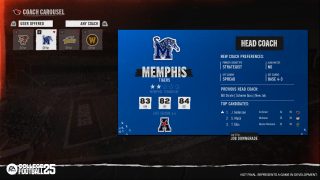
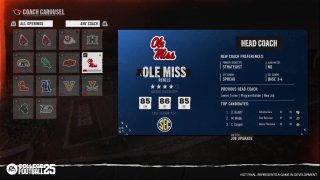

MANAGING YOUR STAFF
As a head coach, you will now have the opportunity to manage your staff and hire/fire your coordinators. Remember, our Coach Archetype system does not allow you to be great at everything, making who you surround yourself with that much more important. Staff management is your opportunity to build your staff the way you want in an effort to put yourself in the best position to succeed as a program.
You’re Fired!
Managing your staff starts during conference championship week. During this week, you will be able to fire your coordinators. Be careful because this is the only week you can do this. After this week, you are unable to replace a coordinator unless they are hired away by another school.
Your coordinators will not leave unless you fire them or they are hired by another school. Every coordinator has a standard 2 year contract. Once their contract expires, it will be automatically renewed for another 2 years. Of course, if you don’t like them, you can always tell them they’re fired. If your coordinator has one year or less remaining on their current contract, there is a chance they will be poached and leave for another school. If this happens during the carousel, you will have the opportunity to hire a replacement.
Welcome to the Team!
Starting Bowl Week 1, you can hire new coordinators if you have an open position. When you go to hire a new coordinator, you will be presented with a curated list of candidates. These coaches are chosen for you based on the needs of your school. The logic that is used to determine the list is similar to the AI school logic to determine their top candidates.
When looking at a candidate, you will be able to see their current school, active archetype, coach level, and what schools are interested in them. These are the schools you would be competing with if you made them a job offer. You can also view the coach’s talent tree, so you can drill down more deeply and see whether or not they would be a fit with your staff.
When you make an offer to a coach, it is not a guarantee that they accept it. You can only offer one coach per position each week and once you have offered them, they will appear in your staff management screen with an “Offered” tag. When you advance the week and re-enter the screen, you will find out whether or not they accepted your offer. If they did, they will join your program after the National Championship game when we process all coach moves. If they rejected your offer, you will have the opportunity to offer another coach. You will always have at least one coach available to hire who does not require you to compete with another school. If at the end of the carousel you have not been able to fill an open position, you will be automatically given a new coordinator that is on par with the caliber of your program..
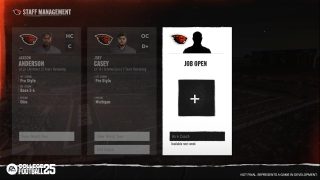
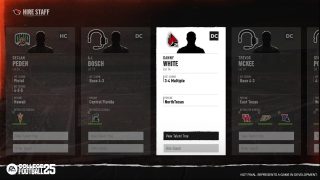

BUILD YOUR PROGRAM
There is no question that in today’s world, roster management and talent acquisition are at the forefront of college football and building your program. Players can now transfer whenever they want and they have expectations for you and your program. Some are looking to play early, others want to win championships and play in big time games, and stars want to grow their brand beyond the field. Aligning what you and your program can do for them has never been more important.
We began our design process by talking with current and former coaches, players, and recruiting experts. What is recruiting and roster management like in the current era? How have player motivations changed? What causes a player to transfer? What differentiates a big time program from a smaller school when it comes to how they operate on the recruiting trail?
At the same time, we spent a ton of time doing quantitative research. We wanted to know anything and everything about recruiting and program management. This ranged from how many 5, 4, and 3 star prospects there are every year to what makes a California quarterback different from a Florida quarterback. We focused heavily on the different geographic regions and what they are known for, as well as researching the recruiting journeys of hundreds of prospects. Why did they ultimately sign with the schools they did? What did the schools in their top 5 and top 3 have in common with each other? Why did they visit some schools, but not others? What role did the head coach and coordinators play in their recruiting process?
Lastly, we spent time talking with our community on what they expected from recruiting and program management. Players liked the recruiting in older games because it had depth, but it was also tedious at times. On the contrary, the latest iteration was fast, but it was also shallow and cold. You never actually felt like you were establishing a relationship with the prospect. We wanted to find a way to blend the two so that recruiting felt meaningful and allowed you to build a connection with recruits through discovery, while also being conscious of your time each week.
Ultimately we landed on four core goals when building your program:
- Humanize recruits by giving them unique needs and motivations that the player has to discover by interacting with the recruit
- Differentiate regions of the country by player caliber, quality, and type to authentically capture high school talent based on historical real-world data
- Represent the different resources available to schools ensuring the top schools can blanket the country, while smaller schools will need to be more targeted with their approach
- Make the transfer portal feel authentically unpredictable
WELCOME TO STAGED RECRUITING
In College Football 25, we are introducing a new Staged Recruiting experience, built around three distinct phases: Discovery, Pitch, and Close. Just like the real world, every recruit will be in a different stage of their process. Where they are in their process will dictate how you interact with them and the level of engagement they require.
Recruiting begins with Discovery. In this initial stage, you are finding which prospects to target, what their skills are, and what they care about most. This stage is all about uncovering information about the recruit as quickly as possible. The sooner you can discover how well they align with your program the better, as time is of the essence.
Once a recruit announces their Top 5 schools, it’s time to Pitch. During the Pitch phase, you are selling the recruit on your program and what you offer. How well your school aligns with their motivations will determine how successful you are.
The final stage is to Close. This is when you bring the recruit in for an official visit and attempt to leave a lasting impression about your program. If the visit goes well, you’ll make huge gains with the recruit and possibly secure a verbal commitment following the visit. Ultimately, the recruit will make their final decision on National Signing Day.
Before we dive deeper into each of these, let’s start by discussing how every program and recruit is unique.
MY SCHOOL
When we talk about there being 134 ways to play, we are talking more than just on-field gameplay. Every school is graded from D- to A+ across 14 different categories, which comprise their “My School Grades”. These grades define who a program is and what their strengths and weaknesses are. No two programs are the same and the grades will dynamically change over the course of your Dynasty based on school performance and actions. The 14 grades are as follows:
- Playing Time: This represents how long it will take for a player to become a starter at their position. Playing time is individualized to each recruit and player based on their position group and OVR.
- Playing Style: This is a representation of how you play. Every player archetype has a stat that is tracked over the course of the season. How high that stat is relative to other teams determines your grade. For example, Field General quarterbacks playing style grade is driven by passing yards per game.
- Championship Contender: This measures how close the team is to winning a championship. It takes into account the team’s current ranking and roster composition.
- Program Tradition: This is a holistic view of a program’s history and success overtime based on the number of Conference and National Championships, total wins, and awards won.
- Campus Lifestyle: This is a representation of the city and area surrounding the campus, as well as the campus itself. This grade cannot be changed or impacted.
- Stadium Atmosphere: This is driven by the stadium’s Toughest Places to Play ranking, which is determined by a team’s historical performance in home games.
- Pro Potential: This is a projection of how likely it is that players on the current roster will play on Sundays.
- Brand Exposure: This grades a team’s overall brand recognition, the potential NIL opportunities a player could get at the school, and how often the school plays in primetime games.
- Academic Prestige: This ranks all universities based on real world academic rankings. This grade cannot be changed.
- Conference Prestige: This represents the overall strength of a conference based on each conference member’s team prestige.
- Coach Prestige: This is a reflection of the school’s coaching staff. The Head Coach carries the most weight here, but coordinators are also taken into account.
- Coach Stability: This measures how long the coaching staff has been in place and how likely they are to remain there for the next 4 years.
- Athletic Facilities: This grade measures the quality of athletic facilities for the program. Waterfalls and barbershops are a plus here.
- Proximity to Home: This grade is unique to each recruit and is based on where the school is in relation to the recruit’s home pipeline.
Each grade has a unique set of grading criteria. For example, Playing Time is graded on a per player basis. The player’s OVR (or projected OVR if they are a recruit) is compared to the team’s roster to project how many years it will take for them to become a starter. Actions you take on the recruiting trail will impact the playing time grade of both recruits and players on your current roster. Even if a player is a starter today, signing new players in recruiting may negatively impact their playing time grade and cause them to enter the transfer portal.
On the other hand, Championship Contender uses a combination of your Top 25 poll ranking, team prestige, and an assessment of your current roster quality with Bud Elliott’s Blue Chip Ratio, which looks at the percentage of your roster that is made up of four and five star players.
Finally, there’s Brand Exposure, which is a reflection of your school’s brand and the potential NIL opportunities a player could earn at your school. While you won’t see players having a mustard named after them in College Football 25, recruits and transfers alike will assess their NIL earning potential and branding opportunities when considering where to go.
Most grades update dynamically throughout the season, while some only update at the end of every season. It’s important to keep tabs on your grades throughout the season and how you are trending because a slide in your grades could trigger decommitments from verbally committed recruits or a sudden transfer portal exodus at the end of a season. Your grades also play a pivotal role in recruiting and will determine how well your pitches land with a recruit.
You can see all of your grades and detailed information about them in the My School screen, which can be accessed from the Recruiting Hub. This screen allows you to assess your school’s current strengths and weaknesses, as well as how you can improve each grade to become a stronger program. Highlighting a grade will show you the steps you can take to improve it, where you are currently ranked amongst other teams, as well as the players are at risk of transferring because they have a Dealbreaker attached to that grade. More on Dealbreakers and why a player would decide to leave later.
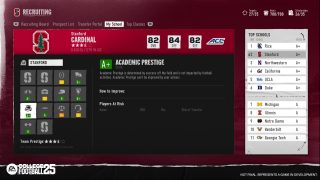

Each week, the game will surface this information to you in a weekly summary allowing you to quickly see the health of your program and any changes. The My School report will show you grades that were positively or negatively impacted by your actions in the last week, as well as any grades that have players who are at risk of transferring if it gets too low.
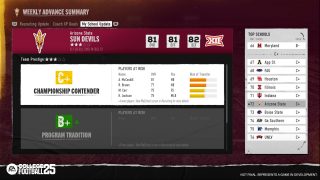
Collectively, your My School grades form your Team Prestige, which can be thought of as your “My School GPA”. Team Prestige grades teams from 0 to 5 stars in half star increments based on their current My School grades. Very few programs will achieve elite five star status and even fewer will be able to maintain it for a prolonged period of time. Ultimately, Team Prestige plays a pivotal role in recruiting and the caliber of players who want to play for your program.
Recruits and Where They Come From
Each season more than 3,500 recruits are generated from across the country. Just like the real world, every class is different. Some years have a plethora of great quarterback talent, while others have fewer great prospects. Similarly, the quantity and quality of prospects from each region of the country will vary. Certain regions will be more consistent in the caliber, quality, and type of recruits they produce than others.
For example, Southern California is known for producing great quarterback talent, while East Texas consistently produces some of the best wide receivers in the country. However, we didn’t stop there. We wanted to go deeper to ensure we were capturing the authenticity of high school talent. Yes, East Texas is known for producing great receivers, but more specifically, they are known for how big and physical their receivers are. As a result, you are going to see bigger and more physical receivers coming out of East Texas, whereas South Florida is going to produce incredibly fast deep threat receivers who have a smaller size.
What a Recruit Cares About
There are 14 different motivations a recruit can care about, all of which map one to one with the My School grades described above. Which motivations they care about are influenced by their star rating. A five star prospect is going to care more about getting to the next level, winning championships, and growing their brand with NIL opportunities than a two star will. By contrast, a two star is more likely to care about staying close to home, coach stability, and academics.
Every recruit will have three motivations that they care about. These three motivations form what we call their “Ideal Pitch”. During the Discovery stage, your job as a recruiter is to find their ideal pitch as fast as possible to determine whether or not they align with your program. If a recruit doesn’t align with your program, you are going to have an uphill battle to sign them.
There is a chance that one of their three Ideal Pitch motivations is also a Dealbreaker. Dealbreakers represent a motivation that a recruit is extremely passionate about and will not budge on. If you do not satisfy their Dealbreaker, they will not talk with you. Additionally, a Dealbreaker stays with a player forever, so once they are on your roster, they will still have the same Dealbreaker they had when you recruited them to your school. You can think of this like your promise to them. If you fail to uphold your side of the deal, there is a chance they will decide to enter the transfer portal at the end of the season.
Recruiting Pipelines
When we analyzed historical recruiting data, it was clear that even in today’s day and age recruiting is still highly regionalized. We discussed various recruiting strategies and tactics with current and former coaches, in particular how they handled recruiting in different areas of the country. All of our research and discussion led us to a new way of thinking about pipelines in College Football 25.
First and foremost, it was clear that not every state is created equal when it comes to recruiting talent and pipelines. Having a pipeline in Florida is much more valuable than one in New York. This made clear that the traditional approach of having each state be its own pipeline wouldn’t accurately represent the recruiting landscape. One of our goals was to balance pipelines in terms of the quantity and quality of recruits that come from them, as well as how schools tend to look at them.
The result was reshaping pipelines to represent a geographic region rather than a state. For example, Florida is now broken into three different pipelines: North Florida, Central Florida, and South Florida. Similarly, Metro Atlanta is its own pipeline, Whereas, New York and New Jersey were combined to become a single pipeline. In total there are 50 pipelines in College Football 25.
With our newly shaped pipelines, the next step was to look at every school’s recruiting classes each of the last 10 years to identify which parts of the country they primarily recruit in. Using this data, we developed a tiered ranking system to represent how strong a school is in a given pipeline. Each pipeline has five levels and every school was given a pipeline level based on historical data. The higher your pipeline level, the stronger your influence is in the region. This will boost a recruit’s initial interest in your school and the impact of your pitches.
A school’s pipeline level will never change, which ensures that schools who are historically strong recruiters in a given region will always have an advantage. For example, Florida has historically dominated recruiting in Central Florida in areas like Lakeland, Tampa, and Orlando. Similarly, LSU regularly reaches into East Texas and all along the gulf coast. This also accurately reflects the challenges of recruiting to a small school that is not located in or adjacent to a strong pipeline.
Generally speaking, your school’s pipelines will heavily influence the types of players you will be able to get and where they are from. The bonuses for being the highest tier in a pipeline are extremely strong and schools are incentivized to recruit their pipelines. As Oregon, expect to compete often with the likes of Washington and USC for players in Southern California and Arizona.
Together, pipelines and Dealbreakers create a much more realistic and less exploitable recruiting experience. While it’s still possible to land four stars as a small school, it will require the right fit and a heavy investment of resources and time. Our hope is that you will no longer have to make custom house rules in your Online Dynasty to prevent your friend from cheesing the system.
Initial Interest and Top Schools
Every recruit will start with a list of schools they are interested in. When a recruit generates their initial top schools list, they evaluate every school’s My School grades in relation to their ideal pitch and motivations. They also take into account their home pipeline and proximity to home. This means that recruits from Atlanta are more likely to have schools from the Southeast in their initial top schools. However, some prospects will look to leave home and play for a school further away if schools outside the region better fit their needs or if they don’t consider any schools in the area good enough for them.
Similarly, most of the top schools for a prospect who values academics are going to be very similar to one another. For example, as Rice, you will often see that the recruits who are interested in your school are also interested in Vanderbilt, Northwestern, and Stanford due to their high Academic Prestige.
Depending on the motivations and location of a recruit it is possible for them to be open to hearing from any school or already narrowed down to a Top 8 or even the Top 5.
Once recruiting starts, recruits will narrow down their top schools over time going from Open, to Top 8, Top 5, Top 3, and ultimately commitment. Your job is to stay above the cutline each week. Great recruiters will quickly recognize losing battles and pivot their resources to a different prospect with more promise of commitment. After advancing the week, you will be shown a recruiting summary of any changes in recruit statuses, so you can quickly identify where you need to spend your time that week.
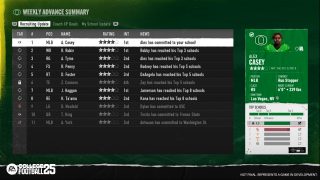
STAGE ONE: DISCOVERY
The first stage of recruiting is Discovery where your goal is to learn information about the prospect as quickly as possible. The faster you can learn information about the prospect, the sooner you can decide whether or not to pursue them. Discovering intel and information about the recruit is also pivotal in how you craft your pitch and sell your school to the recruit. Uncovering that information before your competition gives you a huge advantage.
Prospect Identification
Discovery starts with prospect identification. You can find prospects to recruit from the Prospect List. The Prospect List defaults to the Recommended filter, which identifies recruits who would be a good fit for you. The Recommended filter uses the same logic as the A.I. when they are identifying players to recruit. It takes into account your team position needs, what pipeline a recruit is from, a recruit’s interest in your school, and their star rating.
You can quickly filter the prospect list by using the L2/LT position filter or the R2/RT filters, which allow you to filter by top prospects, star rating, and state. If you’d like more control in your search, you can use the advanced search feature by pressing Triangle/(Y) from within the prospect list. Advanced search allows you to search for prospects that match a specific set of criteria. You can search for recruits using the following criteria:
- Position
- Player Type (Archetype)
- State
- Minimum star rating
- Height
- Weight
- Handedness (Quarterback only)
- Interest in your school
When viewing a recruit in the Prospect List, you will be able to see bio information about the recruit, as well as key recruiting information like whether or not they have a dealbreaker, if they satisfy a team need, how interested they are in your school, their recruiting stage, and how many scholarship offers they have.
Once you find a recruit you are interested in, you can go ahead and add them to your board by pressing (X)/(A). Keep in mind that you can only have 35 prospects on your recruiting board at a given time.
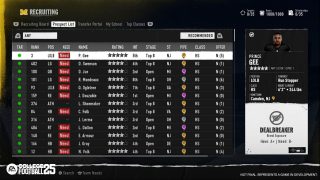
Team Needs
When setting up your board, it is important to understand your current roster’s strengths and weaknesses. How many players are graduating next season? How many returning starters are you going to have? Within any of the recruiting screens, you can press R3/RS to quickly see your needs at every position.
The Team Needs spreadsheet will show you an overall letter grade for each position, as well as a breakdown by school year for the players who are currently on your roster. It will also show you how many additional players you need at the position and the number of players you’ve signed and targeted at that position.
How many players you need at a position will vary by scheme. For example, if you run a pass heavy offensive scheme like the Veer and Shoot you will need 10 wide receivers. Whereas a Pro Style offense only needs 6. Your scheme is tied to your playbook and the only way to change it is by changing your offensive and defensive playbooks, which can be done at any time. As you continue to target and sign players, your team needs will update accordingly.
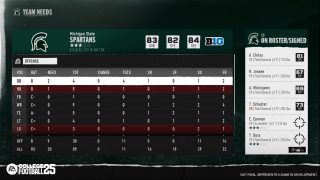
Recruiting Hours
Recruiting hours are your core currency to spend on recruiting actions and scouting each week. The amount of recruiting hours you have depends on your team prestige and what part of the season you are in.
Teams with a higher team prestige will have more recruiting hours each week. This is meant to model the recruiting resources a program has, with higher tier programs having significantly more resources available to them. For example, in the preseason a five star program will have 1,000 recruiting hours compared to only 350 hours for a one star program.
The time of year also impacts your recruiting hours. During the preseason and in offseason recruiting, you do not have to prepare for a game each Saturday. As a result, you have significantly more time to spend on recruiting than you do in the heart of the regular season.
In addition to the maximum recruiting hours you can spend in a week, each prospect has a maximum number of hours that you can spend on them in a given week. The default maximum is 50 hours, but this can be increased to a maximum of 70 hours with the Always Be Crootin’ ability for that position.
Recruiting Board
The Recruiting Board is where you will spend the bulk of your time in recruiting. The general layout of the board will be familiar to many. On the left, there is a list of all of the recruits who are currently on your board. Each recruit shows high level information about their status, including how many hours you’ve allocated to them, how much you’ve scouted them, if you’ve offered a scholarship, if you’ve scheduled a visit, their stage, and their interest level in your school.
You can filter the list using L2/LT. For example, you can filter by prospects who are ready for a visit, prospects you haven’t offered a scholarship to, recruiting stage, position, and more. You can also sort the board by national rank, interest status, and recruiting stage. Of course, the board can also be manually re-ordered using R2/RT.
Selecting a recruit allows you to dive in deeper and begin interaction with them. At the top of the screen, you will see bio information about the recruit, as well as a large bar with stages on it. This bar represents the recruits overall progression towards each stage and ultimately committing to a team. The dark area of the bar is how much the recruit progressed week over week.
Within the Overview tab, you can see a summary of where each school stands. Similar to the top bar, each school has their own bar, which represents their progression with the recruit. The top schools list is a zoomed in snapshot of the recruit’s progression to the next stage. Once a team fills their bar, the recruit will progress to the next stage and the top schools bars will reset. Any teams below the cutline will be locked out and no longer able to talk with the recruit.

Scouting
Before you start offering scholarships and dedicating your limited recruiting hours and resources to prospects, it is important to make sure you’re targeting the right ones for your program. During the preseason, you are only able to scout and offer scholarships, so it is a great time to scout players and ensure you are targeting the right prospects. In College Football 25, we are introducing a new scouting system designed to represent the ambiguity and progressive discovery of a High School player’s skills.
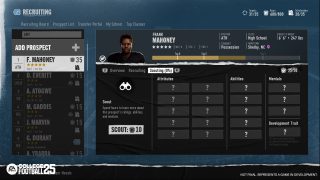
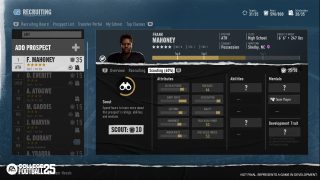
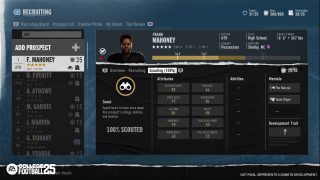
Prior to scouting a player, you will only be able to see their star rating, height, weight, hometown, position, and archetype. You will see question marks on their attributes, abilities, and development trait. The attributes represent the top 10 ratings for their archetype.
Each attribute has 4 states of scouting:
- Unscouted: This is represented by question marks and is the default state for every recruit.
- Partially Scouted: At this stage you will see a horizontal bar appear. The left side of the bar is 0 and the right side is 99. Within the bar is a gold zone that covers 25% of the bar’s space. The player’s true rating for that attribute is somewhere in this range.
- Mostly Scouted: Once you have mostly scouted a player’s attribute, you have a much clearer picture of the prospect. At this point, the gold zone only covers 10% of the bar.
- Fully Scouted: When a rating is fully scouted, you know exactly how good the prospect is and their exact attribute rating is revealed.
Each time you scout a prospect, you will reveal a limited amount of information about them. Sometimes scouting a player will fully scout an attribute, while other attributes may be only partially scouted. Additionally, each scouting action will also reveal Physical and Mental Abilities.
While attributes and abilities are able to be scouted, a player's development trait is not. When we talked with coaches about identifying a player’s development trait, they overwhelmingly said it is an intangible factor that is difficult to identify without a distinct intuition and direct in-person contact with a recruit. As a result of our discussions, the primary time you will unlock a prospect’s development trait is on National Signing Day. However, if you own the Mind Reader ability, there is a chance you will learn their development trait when you spend time with them during their official visit.
The coaches we talked with also described how the level of ambiguity and uncertainty around a player’s skill set is higher for lower star rated players. This is because of how much visibility the top prospects get from social media, scouts, and high profile camps. Conversely, lower star rated recruits generally have less visibility, which leads to a greater level of uncertainty and unknown what their true skill is. This creates an opportunity to find a diamond in the rough.
We have modeled this uncertainty and unknown with our gem/bust system. When scouting a player, there is a chance you identify that their true skill is actually better or worse than their star rating indicates. For example, a 4 star bust is really a 3 star quality prospect, while a four star gem has the skill level of a five star. Of course, even if a player is a bust, it doesn’t necessarily mean they are a bad player. A five star bust is still going to be pretty darn good.
This system creates a lot of variance in lower star rated prospects and provides you with the opportunity to build your program with high quality players who slip through the cracks of the recruiting rankings. Landing top blue chip prospects is incredibly difficult, so this can be a highly effective recruiting strategy to build your program. Think back to the rise of Boise State and the consistency of Oregon State in the early to mid 2000’s. Both of these programs excelled at finding gems who were under-recruited and overlooked by big schools.
Finding the Ideal Pitch
Once you’ve determined a prospect meets your initial criteria, it is time to begin uncovering intel about their motivations and what they care about. Remember, every prospect has three motivations they care about, which comprise their “Ideal Pitch”. Your goal is to discover their Ideal Pitch as quickly as possible, so that you know if their motivations align with your program and so that you have the information you need when you begin pitching in Stage 2.
In Stage 1, there are five recruiting actions you can use to uncover information about the prospect. In addition to uncovering information, you will also gain some influence with the prospect. Each action has a recruiting hour cost and corresponding benefit. The more hours you spend on a recruit, the faster you will uncover information and the more influence you will gain. You can increase how fast you uncover information and the amount of influence you earn with the Most Influential ability, which gives a bonus to recruiting actions.
The five recruiting actions are as follows:
- Offer Scholarship: Scholarships show the prospect you are very interested in them. As a result, you will gain a small weekly influence bonus with the prospect after offering them a scholarship. Additionally, you will not be able to bring them on campus for an official visit or receive a commitment from a prospect until you’ve offered them a scholarship.
- Search Social Media: Spend some time scrolling through the player’s social media to learn a little bit more about them. This will also give you a very small amount of influence when they see you liked their story. Just be careful not to like an image from three years ago.
- DM the Player: Message the player directly on social media to start a conversation and learn more information about them. DMs will give you a small amount of influence as you start to build that relationship.
- Contact Friends and Family: Make a few phone calls to the player’s family and close friends to learn a lot more about what the prospect values. This action will also gain a significant amount of influence with the prospect when word gets back to them that you called and when Grandma starts raving about you and your program at Thanksgiving dinner.
- Send the House: From the recruiting coordinator to every other coach on your staff, send every available resource you have after a prospect to gain as much influence with them as possible.
As you uncover their motivations they will no longer display a question mark. If the motivation displays a red X, the recruit does not care about it. If it displays a green checkmark, this is one of the three motivations they care about.
With this added depth in recruiting, we wanted to make sure that recruiting did not become a monotonous chore that took a significant amount of your time each week. With this in mind, every recruiting action is “set it and forget it”, meaning they will stay week over week until the recruit either locks you out, commits, or you decide to change your recruiting actions.
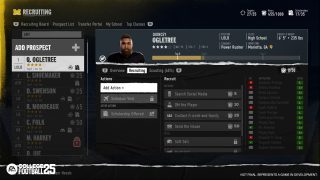
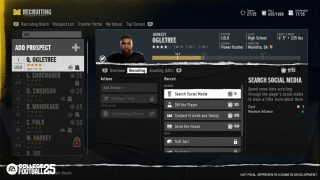
STAGE TWO: PITCH
After the recruit narrows their top schools to five, it is time to begin pitching the prospect on your school and what you have to offer. By this point, you should have a good amount of information about the prospect and what they care about. The more information you have, the more surgical you can be with your pitch. If you do not have much information about the prospect, you will effectively be flying blind and risk pitching them on something they do not care about. If your pitch does not align with their motivations, it can actually have an adverse effect on their perception of you and your program.
When pitching a prospect, there are two different pitch types you can use:
- Soft Sell: Awards a moderate amount of influence when choosing the correct pitch. It also limits the downside risk and penalty of pitching the prospect on something they do not care about. This is best for when you have some idea of what the recruit is motivated by.
- Hard Sell: This provides the most influence when choosing the correct pitch, but it also comes with the largest penalty if you pitch the wrong thing. It is best to hard sell the recruit when you know their ideal pitch or if you are desperate and just hoping for the best.
After selecting a pitch type, you will then select your pitch. Each pitch is a collection of three motivations and there are 20 pitches in total. For example, the Sunday Bound pitch sells a recruit on your school being a championship contender, its conference prestige, and your school’s track record of sending kids to the next level. How well the pitch aligns with the prospect’s motivations, as well as your associated My School grades will ultimately determine how well your pitch lands with the prospect. You can increase the impact of your My School grades with the Upsell ability.
If your school does not perfectly align with their ideal pitch or if you are looking for a way to get a competitive advantage, you can sway the prospect and change their motivations. Successfully swaying a prospect, will give them a second ideal pitch that is only available to you. It is possible that the second ideal pitch also creates a third ideal pitch combination as a result. Your chances of successfully swaying a prospect increase the more overlap there is between their ideal pitch motivations and the pitch you are trying to sway them on. It is possible to sway them on a pitch with zero motivation overlap, but it is a very low probability of success.
For example, let’s say the prospect’s current ideal pitch is Hometown Hero, which includes campus lifestyle, proximity to home, and program tradition. To increase your probability of success, you would want to sway them on a pitch that also has 1 or 2 of the Hometown Hero motivations. In this example, let’s sway the prospect on the College Experience pitch, which includes academic prestige, campus lifestyle, and stadium atmosphere. If our sway is successful, the prospect will now care about academic prestige and stadium atmosphere in addition to the three motivations they already cared about as a part of their Ideal Pitch. A successful sway gives you the ability to pitch two or more ideal pitches for maximum influence gain. It also provides you with the opportunity to more closely align the prospect with your school’s strengths. This is an incredibly powerful action and if used properly it can separate you from the competition.
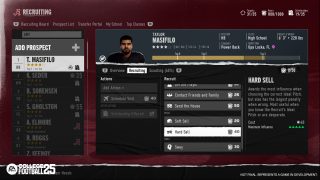
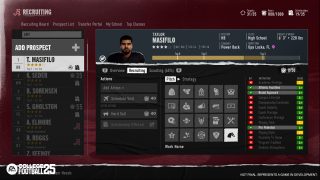
STAGE 3: CLOSE
The final step in the recruiting journey is to Close. This is when you bring the prospect in for an official visit and attempt to leave a lasting impression with them. In order to schedule a visit with a prospect, they must be down to their top 5 schools and you need to have offered them a scholarship. No recruit wants to take the time to visit somewhere that won’t even give them a scholarship offer.
A recruit can only take an official visit to a school when they are on a bye week or they have a home game. Additionally, schools can only host up to four recruits in a single week. When scheduling a visit with a prospect, you will be charged 40 recruiting hours. The cost to schedule a visit does not count towards the maximum number of hours you can allocate to the recruit in a week. This allows you to continue your normal recruiting of the prospect in the same week you schedule a visit.
A visit is broken down into two main parts: Scheduling and Activity.
Timing is everything when it comes to scheduling a visit. Waiting to bring the recruit in for a big time rivalry game late in the season could have a lot of upside, but it also carries risk since there’s a chance the prospect will commit somewhere else prior to your visit date.
Who you play the day of the visit also matters. Every visit during the regular season comes with a set of Gameday Stakes, which determine the influence bonus you will receive with the recruit for winning the game and the potential downside for a loss. The stakes are set by the importance and visibility of the game the prospect will attend. Let’s be honest, nobody wants to go to a game in a weak environment. Playing a lower tier opponent will provide very little upside and major downside if you lose. Conversely, playing your rival who is also a top 5 team will have the potential to leave a lasting impression. Of course, you can avoid any risk entirely by scheduling during a bye week, but then you get no game-related bonuses at all.
Finally, the other prospects who are visiting that weekend can have a positive or negative impact based on whether or not their positions are complementary or competitive. For example, having a quarterback and left tackle visit at the same time will give a complimentary bonus, whereas scheduling two quarterbacks on the same day is considered a competitive visit and will negatively impact both of their visits.
After setting which date the prospect is going to visit, the next step is to select what they are going to do on their visit. There are 14 activities a recruit can do during a visit and each activity maps to a prospect motivation. Similar to pitches, the alignment of the recruits interest level in that activity and your My School grade will determine how much the recruit enjoys the activity.
Nailing the visit can often be the difference between bringing in a Top 5 class or being left at the altar on signing day. If things go well, there’s a chance the recruit will verbally commit to your school following the visit.
While you should feel good about securing a verbal commitment, it is critical you stay on top of things until they sign their letter of intent on signing day. If a prospect is verbally committed and they have a Dealbreaker, they will decommit from your school if you fall below the required grade threshold prior to signing day. Once a player has signed on signing day, you have nothing to worry about until they arrive on campus and your next challenge is keeping them happy and out of the transfer portal.
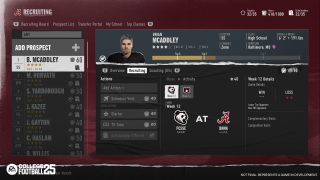
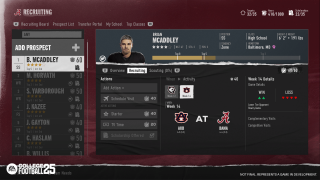
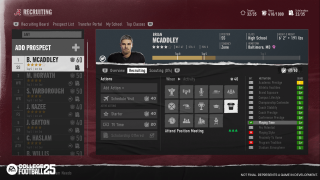

HEY COACH, I’M SORRY, BUT I’VE DECIDED TO LEAVE
Over the last three years the transfer portal has completely reshaped college football and how you build your roster. While it can be used to quickly upgrade your roster, it can also gut your program if a mass of players head to the exits.
Just like recruits, players on your roster can also have a Dealbreaker and any recruit that has a Dealbreaker will keep their Dealbreaker when they join your roster. Remember, Dealbreakers can be thought of as a promise between you and the player. If you fail to uphold your end of the deal there is a chance they leave in the offseason. The corresponding My School grade falling below the threshold does not guarantee that they will decide to leave. The probability of a player transferring after their Dealbreaker has been violated is driven by their OVR with higher OVR players being more likely to transfer.
Keep in mind that every action you take throughout the season has the potential to impact your My School grades and therefore increase a player’s chance of leaving. A perfect example is the coaching carousel, where coach firings or coaches leaving for new jobs could immediately impact a team’s Coach Prestige grade resulting in players entering the portal.
In addition to players entering the portal, high OVR players may look to go pro and enter the draft if they’ve been in school for 3 or more years. Players who are entering the pro draft will display the round they are projected to be drafted in.
Once a player has decided to leave, you will have an opportunity to persuade them to stay. The chance to successfully persuade a player to stay is determined by their OVR and your coach prestige. Higher OVR players will be harder to convince than low OVR players.
However, keep in mind that you only have a limited number of persuasion attempts. The number of persuasion attempts you have is determined by your coach prestige. The higher your coach prestige, the more attempts you will have. You can increase the number of persuasion attempts with the Gift of Gab ability and you can increase your chance of successfully persuading a player to stay with the Roster Retainer ability. Both of these abilities are available in the Program Builder archetype.
After advancing the week, you will be able to see the pro draft results which show where players were drafted. When creating the pro draft results, we use real world data and pro draft trends to inform when players are drafted based on their OVR and position.
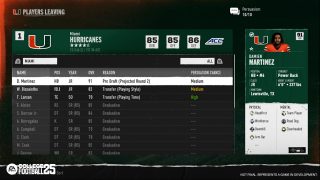
I THINK IT IS BEST IF YOU PLAY ELSEWHERE
While players have the opportunity to leave via the transfer portal every season, you will also have the opportunity to make roster changes. Every offseason you are required to get back down to 85 players on your roster. Unfortunately that means if you are over the 85 man limit, you will be forced to encourage some players to transfer and find a new home. Even if you are at or below 85 players on your roster, you can still encourage players to transfer in order to make room for new players the next season. And no, you can’t encourage the brand new freshman you just signed to find a new home the moment he gets on campus.
THE TRANSFER PORTAL
As we said at the beginning, one of our goals was to make the transfer portal authentically unpredictable. This begins with players leaving. Some schools may face a mass exodus of players, while others may be left untouched. Once all players have decided whether to stay or go, the transfer portal will officially open at the start of offseason recruiting.
Offseason recruiting lasts four weeks in total and transfers will make their final decisions at the end of it on National Signing Day. Just like in real life, this is a chaotic four weeks where players are committing quickly and team rosters are rapidly changing. Teams will have to constantly make quick decisions, sometimes with limited information. Do you want to continue pursuing high school recruits? Are there transfers who can immediately improve your roster? How much time do you want to spend discovering a transfer’s motivations and scouting them versus selling them on your program? How soon do you want to bring a transfer in for a visit?
Every transfer is given a star rating based on their OVR and has a national, state, and position ranking just like high school prospects. Since people change over time, transfers are assigned a new Ideal Pitch and motivations. Every player in the transfer portal has the same dealbreaker that caused them to transfer originally. Their new Ideal Pitch will include their dealbreaker motivation and it will be relevant to transfers and their unique needs.
After their new Ideal Pitch and motivations have been set, transfers will evaluate every school and generate a top schools list just like high school prospects do. They will look at how their motivations align with each school and adjust for pipelines and proximity to home.
Since four and five star prospects are in the highest demand and they know more concretely what they are looking for, they will only consider five schools. If you are not in their top five, you will not be able to talk with them. Lower star rated prospects will vary in terms of the number of schools they are considering. Some will be completely open, while others will have as few as three schools they are considering.
Regardless of where they start, the process of recruiting a transfer is fast and you will need to make quick decisions. Your interactions with a transfer will be very similar to interacting with a high school recruit. Depending on their stage, you will add recruiting actions, pitch your school, and bring them to your campus on a visit to try and close the deal.
When evaluating whether to target transfers or high school prospects, schools will look at each position on their roster throughout the season and monitor their immediate needs. If a position group does not meet their requirements, they will hold a spot on their recruiting board for an offseason transfer who they believe can come in and be an immediate contributor. Don’t be surprised if you see teams finish Early Signing Day with a light recruiting class in preparation for a big recruiting push in the transfer portal.
Of course, once they see the players who are actually in the portal, their priorities may change. Having a need at left tackle is nice and all during the season, but if there’s a five star transfer quarterback who wants to come to your school, why turn them down?
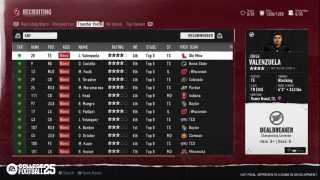
SIGNING DAY
Just like the real world, College Football 25 features both Early Signing Day and National Signing Day. Early Signing Day takes place at the start of Bowl Season after the regular season has been completed. National Signing Day takes place seven weeks after the National Championship.
On signing day, any players who have verbally committed to a school prior to signing day will sign, meaning they can no longer decommit. The majority of prospects will commit prior to Early Signing Day, but some recruitments may last late into the cycle. Those prospects, along with transfers, will ultimately sign their letter of intent on National Signing Day.
Throughout recruiting, you can view the team recruiting rankings in the Top Classes tab of the recruiting hub. Top Classes allows you to view the team recruiting rankings for high school prospects, transfers, or combined. You can also filter the rankings by conference.
Any recruits who are unsigned after National Signing Day will stick around and become walk ons in the offseason. With that being said, the days of a player who was being actively recruited not committing anywhere and drifting off into the ether are over! No longer will you have to speculate and fantasize what happened to them. Did they fail to get into school because of grades? Did they have a change of heart and decide to try archery instead? Was it something you said? Now the team with the highest influence on Signing Day will get the player as long as they have offered them a scholarship. This was a huge quality of life improvement that we all felt was a must have and we are very happy we were able to deliver it.
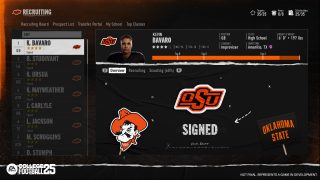
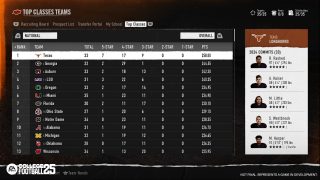
POSITION CHANGES
Following signing day, you will have the opportunity to change player positions ahead of off-season progression. This is especially important for any athletes you signed in recruiting as they do not have an actual position. If you forget to set an athlete's position, they will be automatically assigned their primary archetype’s position when you advance the week.
Players will be able to change to any other position regardless of their original position. The position change spreadsheet will show you their projected overall at the new position, which archetype they would become, where they would rank on the depth chart, and the number of players at the position. Once you confirm their new position, they will receive a new set of physical abilities that are specific to that archetype. The physical abilities and tiers they receive are determined by their new attributes. Mental abilities will not change unless the mental ability does not apply to their new position.
PLAYER PROGRESSION
In college football, the offseason is the most impactful time period when it comes to player development. While players can improve throughout the season, the bulk of their progression and development happens during the spring and summer. Every season we see players who put in the #work during the offseason and come back bigger, stronger, faster, and overall a significantly better player. Player progression in College Football 25 is no different.
All About The Gainz
In Dynasty, players will automatically progress their attributes and physical abilities. Mental abilities cannot be upgraded allowing for greater differentiation between players.
Players will progress during the season based on their on-field performance, but the bulk of their progression will happen in the offseason. Offseason progression happens after the position changes stage, so that players will progress in their new positions. The amount a player progresses in the offseason is influenced by their school year, your coach abilities, and their development trait.
To simulate the real world difference in physical maturity between a freshman and a senior, younger players like rising sophomores will take larger leaps during the offseason than a rising senior. Similarly, a player’s coaching staff will have a significant impact on their development. For example, Motivators can have the Pay It Forward ability, which awards bonus XP to a position group every time a player at that position is drafted in the first three rounds. Motivators can also have the Put in Work ability, which increases offseason development for players in a particular position group. Progression will then be further modified by the player’s development trait.
In College Football 25, there are four player development traits:
- Normal: These players are most common, and progress at a standard rate. Expect them to steadily grow over their career.
- Impact: The type of player that can really change a team. They’ll progress faster than normal, with higher upside.
- Star: A potential Sunday player. There are very few of these to go around and they’ll establish themselves early as fast learners.
- Elite: The best of the best. These players will make a statement the moment they get on campus and have the potential to be an all-time great.
Once a player is on your roster, their development trait is known and can be seen in the player card, which can be accessed by pressing Triangle/(Y) on a player on the roster screen. When a player is a recruit, their development trait is hidden until National Signing Day, unless you have the Strategist archetype’s Mind Reader ability, which gives you a chance to learn their development trait when they come in for an official visit.
Skill Groups
As opposed to progressing each attribute individually, for example Trucking, players will instead progress an entire Skill Group. A Skill Group is a collection of related attributes, for example the running back Power skill group includes Trucking, Strength, Stiff Arm, Toughness, Jumping, and Injury. Every Skill Group has a max level of 10. Each time you upgrade a skill group, it will increase one level and progress all of the attributes in the skill group. With that being said, some players will have a Skill Group max level or cap that is less than 10.
Skill Group caps can be thought of as a player’s max potential in that particular area. These will vary by player, Skill Group, position, and archetype. Once a Skill Group has hit the cap, it can no longer be upgraded unless the coach has the Architect archetype and the Limitless or Put a Ring on It abilities. Limitless provides a chance to increase a random skill cap every time the player levels up and Put a Ring on It provides a chance to increase their highest skill cap after winning a Conference or National Championship.
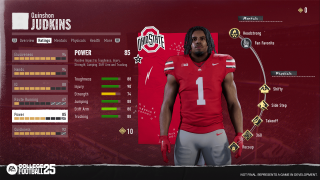
Mental and Physical Abilities
As Scott described in the Gameplay Deep Dive, players can have up to five physical abilities and three mental abilities. Both physical and mental abilities have four tiers: Bronze, Silver, Gold, and Platinum. Physical abilities are determined by the player’s archetype, while mental abilities are position specific.
While progressing, players will look to upgrade their physical abilities if they meet the rating requirement. Every tier of a physical ability has an associated attribute requirement. For example, in order to have the platinum Workhorse ability, a player must have 95 Toughness. As said above, Dynasty players cannot upgrade their mental abilities. So if a player does not come in as a freshman with a particular mental ability, there is no way for them to earn that ability through progression.
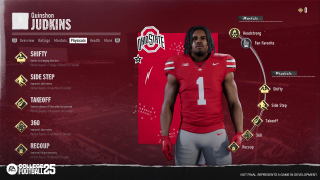
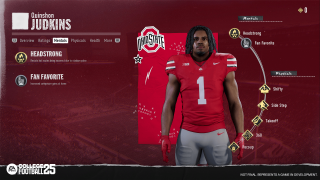
IMPACT PLAYERS
Impact players are back and are a quick way for you to easily identify the key players on the other team. Every team will have at least one offensive and one defensive player who is an “Impact Player”. However, unlike the past, there is no limit on the number of Impact Players a team can have. Explosive offenses with playmakers everywhere might have five or six Impact Players across the board letting you know straight up that they got dudes and they are about to cook.
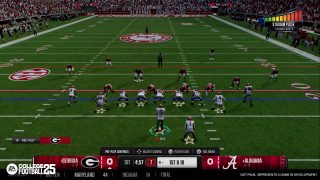
MANAGING WEAR AND TEAR
With the introduction of the new Wear and Tear system, the week to week management of your players is more essential than ever before. As described in the Gameplay Deep Dive, players can incur damage to body parts during gameplay. The more damaged a body part is, the more it will impact their on-field performance. In addition to on-field gameplay, players will also incur Wear and Tear damage during SuperSim.
Each week, players will recover some of their wear and tear damage. The amount of recovery is dependent on how damaged the body part is. For example, let’s say in the previous game your running back severely damaged his right ankle and his left shoulder was only slightly damaged. The next week you can expect his shoulder to be fully recovered and his ankle to be only slightly recovered. His ankle would then be something you want to monitor in the next game.
You could decide to sit him in an effort to allow him to get back to full health the following week or you could play him at the risk of increasing how long it takes him to fully recover. In an effort to ensure that players are not disappearing in big time games late in the season, we have set minimums that players will always recover to when advancing the week.
You can monitor your player’s Wear and Tear damage by viewing the health tab in their player card. To access this, go to the roster spreadsheet and press triangle/(Y) on a player. This screen will show his damaged body parts and associated ratings impacts.
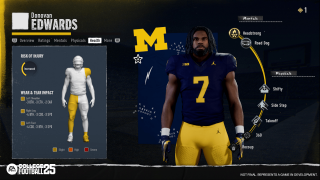
DELIVERING THE WORLD OF COLLEGE FOOTBALL
One of the biggest challenges we faced in the development of College Football 25 was the task of recreating everything that makes the sport of College Football so unique. Unlike most professional sports where so much of the league is templatized and where uniformity helps drive a quest for parity; College Football is a sport that marches to the beat of its own drum. It’s a sport that thrives on the chaos created by that very lack of conformity. And while that lack of conformity makes College Football so special, it also makes the task of building the world of College Football so much more challenging.
So let’s talk about those elements that help immerse you in your coaching journey and the recruiting trail.
A NEW DAY IN COLLEGE FOOTBALL
A lot has happened since we last made a college football game, most notably the entirety of the 4-team College Football Playoff format has come and gone, But this year starts a new day for College Football with the 12 team format, and you get to experience it first in College Football 25!
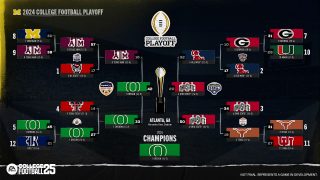
There are a lot of intricacies with how the new College Football Playoff format that college football fans will need to get used to. During development, members of our team were able to participate in a mock selection committee session hosted by the CFP to help us better understand the process of how the committee determines their rankings. With the expansion to the new 12-team format we were able to apply those learnings to project how the committee will value wins and losses in a world where going undefeated in a power conference is going to be less and less common and the perception of schedule imbalance continues to widen.
While the Media and Coaches Polls run throughout the entire season, you will need to wait for the calendar to turn to November before you start to get the first peek at how the 12-team bracket is shaping up. That will be your first look at both the CFP Top 25 as well as how the playoff would be seeded based on those rankings/seeding rules.
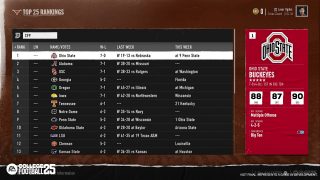
We created unique logic for our College Football Playoff Poll to model how we anticipate the rankings to look in the new format. Generating a believable opinion based poll is no easy feat, especially one where we are projecting what may happen versus being able to use the real world results as our reference point. “You are what your record says you are” is a misnomer in college football, so factors like school and conference prestige can impact where a school finds itself in the CFP poll. Each week of the season the Coaches, Media and CFP Polls along with the 12-team bracket update based on the most recent results and the final rankings and bracket are revealed following the completion of Conference Championship games.

Once the rankings are set, now it’s time to seed the bracket! As many people reading this already know, the 12-team format is a 5+7 model, meaning the five highest ranked conference champions will get automatic berths into the playoff, and the remaining seven spots will be filled based on order of the final CFP ranking. The only way to get a first round bye is to be one of the four highest ranked conference champions. So an undefeated Notre Dame or any other independent, as well as the winner of the PAC-12 can be seeded no higher than 5th and will never be eligible to skip the Playoff First Round. The 5th automatic qualifier that did not get a first round bye will be seeded based on where they rank in the final CFP poll.
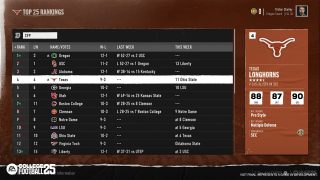
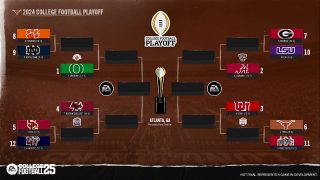
One of the most exciting parts about the new 12-team format is that the first round games will be played on campus! Hosting one of those games means you will have all of your home field advantage on your side as you take on your opponent as you look to win and advance. The Playoff Quarterfinal and Semifinal games take place at the bowls formerly known as the New Year’s 6 (Orange, Sugar, Rose, Fiesta, Cotton, and Peach) which rotate annually each year of a dynasty just like they will in real life. The CFP National Championship game has its own rotation of hosts. Starting with Mercedes-Benz Stadium in Atlanta the championship game will rotate through an additional ten locations before looping back around as you continue deeper into your dynasty.
In addition to the College Football Playoff, we also feature 34 bowl games each using their real world bowl tie-ins, so the R+L Carriers New Orleans Bowl will annually feature teams from the Sun Belt and Conference USA, the TransPerfect Music City Bowl will feature teams from the SEC and the Big Ten, etc.

Just like the CFP bracket, you will get your first look at the bowl projections in the first week of November each season. Each week that you keep winning you can see yourself climb in the polls, playing in a more prestigious bowl, all while trying to earn a berth in the College Football Playoff.
The new era of College Football is here, and by the time the 12-team playoff happens in real life you will already be an expert on how the format works just by playing Dynasty Mode!
MEET YOUR NEW NEIGHBOR
Speaking of the dawn of a new era, the latest round of conference realignment has dramatically changed the landscape of college football and just like the 12 team CFP format, you will get to experience that new reality first in College Football 25!
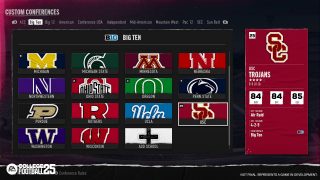
Every conference is set with their 2024 alignment, the Sun Belt is the last conference to feature divisions, and the scheduling logic has been set for both the current season, as well as the future year rotation based on each conference’s rule set. The SEC will accurately follow the 8-game with one protected opponent rotation, while the Big Ten will utilize their 9-game flex protect model, and so on.
If you need a refresher of who’s where, or if you are looking to follow along with the conference races, you can keep an eye on everything on the Conference Standings screen.
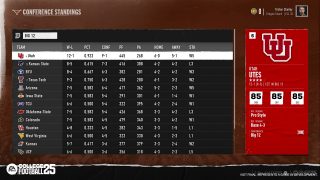
Be Your Own Conference Commissioner
If you prefer to reset conferences to a previous configuration, push forward to a potential future, or just blow everything up and make whatever conference membership you want and adjust the rules to your liking you have the power to be the Czar of College Football and set things how you’d like them with Custom Conferences.
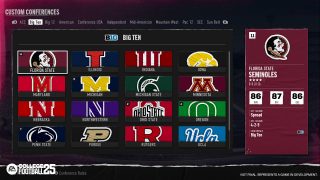
You can reduce any conference to as few as 4 members, and grow any conference to as large as 20 schools. In addition to moving schools into different conferences you can have a school go Independent for the ultimate in schedule flexibility (but remember it comes at the expense of a potential 1st round bye in the CFP).
You will also have the ability to edit each conference’s rules. Determining if they will/will not have divisions, what those division names are, how many conference games will be played annually, if the conference will have a conference championship game, and the location of that championship game either at a neutral site location or at the home stadium of the highest ranked team.
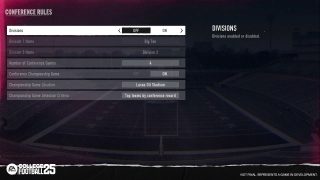
You will be able to make adjustments to conference membership and rules when starting a dynasty as well as at the end of each off-season giving you total flexibility to change things however you want both at the start of a dynasty as well as change the landscape of the future based on your dynasty results to keep things fresh and interesting as you go deeper into your coaching career.
Moving conferences does not mean you are stuck with the old conference’s jersey patch for the logo on the 25 yard lines. Those will dynamically update based on conference membership.
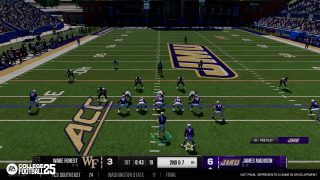

In an Online Dynasty, only the Commissioner can make conference changes.
LET’S TALK SCHEDULES
College Football is unlike any sport in that so many of the weeks of the season mean something special to so many different schools. It’s not enough to make sure that the schedules rotate, and that home and away status gets flipped for the new year. If it’s the 3rd Saturday in October, Tennessee better be playing Alabama. If it’s Thanksgiving weekend then the Iron Bowl, The Big Game, Florida State/Florida and a host of other rivalry games better be on the table next to the turkey and stuffing. Dynasty Mode’s scheduling system will make sure those special games get filled in the correct weeks before adding in the rest of the conference and non-conference slate to get each school to their 12 games.
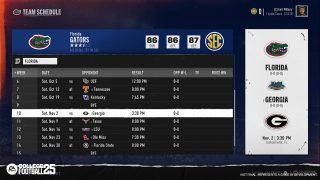
For non-conference games, we have included as many real world games as were announced by the time we had to lock schedules, so when you get to 2027 and 2028 the Florida State/Georgia home and home series will already be scheduled, in 2029 and 2030 the Notre Dame/Alabama home and home will be scheduled, etc. Our schedule generator will be used to fill out everyone’s schedule to make sure that every school has 12 games for all 30 years of a Dynasty.
Kickoff games like the Duke’s Mayo Classic and the Vegas Classic are here as well, and will be scheduled in future years of Dynasty mode.
Another recent addition to the world of college football is the concept of Week 0. While the season still kicks off on Labor Day weekend for a majority of schools, some get things started the week prior in what has been affectionately termed “Week Zero”. The authentic week 0 games are scheduled for year one of dynasty, and in your future years Week 0 will get utilized, however the bulk of the schools will still put toe to leather for the first time in the traditional Labor Day week window.
You can see your team’s entire schedule on the Team Schedule screen, or look at the schedule around the country week by week from Scores/Schedules. Each week the broadcast type will be determined based on what is the biggest game on that week’s slate. If your game is either a national or streaming broadcast it will be called by our team of Rece Davis, Jesse Palmer, and David Pollack. The Game of the Week will be called by Chris Fowler and Kirk Herbstreit.

The Crowd Themes that our friends in Presentation talked about recently also appear in Dynasty. If your school does a White Out, Black out, checkerboard, striping, etc. you will see those crowd themes in the 1st home game of the season, for rivalry games, and if you are named as the Game of the Week.
Set your Schedule
In addition to Custom Conferences, you can also customize your non-conference schedule via Custom Schedules every preseason.
Conference games are designated with a lock icon and cannot be edited, but your non-conference games do not have a lock signifying they are fair game to edit.
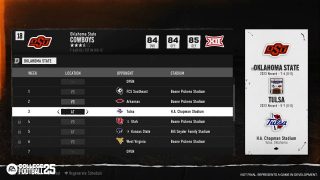
Select any week that features a non-conference opponent or any bye week to be able to select a different team to play in that week. You can only have a max of 12 games, so you will need to remove a game before trying to add a new one.
When you select a week, you will see all of the available opponents that you can choose from. Some schools will not be available if they are already locked into a conference game in that week so you will have more luck finding a larger set of available teams earlier in the season before most schools have started conference play.
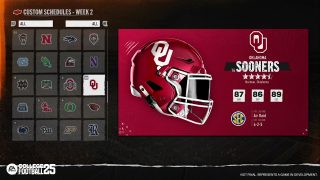

You can also change if the non-conference game is a home or away game by simply toggling the home/away status on the schedule screen.
To avoid the mass confusion of multiple people trying to edit schedules at the same time, the Commissioner in an Online Dynasty is responsible for making all Custom Schedule changes.
TEAMBUILDER IN ONLINE DYNASTY
TeamBuilder is back! You can import up to 16 TeamBuilder teams in a private Online Dynasty. The Commissioner will need to replace existing FBS schools with the TeamBuilder teams they want to add when setting up the dynasty. Including TeamBuilder schools is only available at the creation of the league and they can only be used in private Online Dynasties, so make sure your Commissioner knows which school you want to use when getting the Online Dynasty started.
TO BURN A SHIRT, OR NOT TO BURN A SHIRT
The changes in the world of college football have not been limited to off the field, handling redshirts have also seen a recent overhaul, and to keep in line with the real world we have implemented the ability to play in up to four games in a season and still be eligible to take a redshirt.
Each pre-season you will have the option of selecting which players you for sure want to redshirt, and during the course of the season you can monitor how many games each player has played in in order to make the determination on if you want to keep playing that player, or have him sit the remainder of the year in order to preserve his redshirt status.
Those four games can be played at any point in the season, so you can get a freshman some game reps early in the year and then hold them out until the end of the season and then bring them back in for a playoff run if wear and tear has run your roster down and you need a fresh body when the season matters most.
Once a player has played in their 5th game in a season they are no longer eligible for a redshirt that year, but will be eligible for a redshirt the following year.
If micromanaging redshirts is not your thing, no worries at all, anyone who is eligible for a redshirt at the end of the season will have it automatically applied.
EARNING SOME HARDWARE
College Football loves to celebrate accomplishments, whether it’s reclaiming a 100+ year old water jug from a rival like the annual Michigan/Minnesota game, a coach hoisting up the SEC championship trophy in Atlanta in early December, or The Most Outstanding Player in College Football striking the iconic pose just one week later, College Football and awards are synonymous.
RIvalry trophies will be on the line and the winner of each contest takes home both the trophy and bragging rights for the year.
Conference, Bowl, and National titles will contribute both to your coach’s pedigree but also the school’s Program Tradition grade.
When it comes to individual awards, the conversation has to start with the most storied trophy in all of sports, the Heisman Memorial Trophy which is awarded annually to the Most Outstanding Player in College Football. Each week of the season, keep tabs on the Heisman Watch to see who is in the running for the prestigious award, as the Heisman Race heats up as we get to the award being announced heading into the first Bowl week.

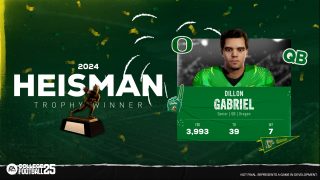
In addition to the Heisman, we have other individual positional awards like the Lou Groza, Lombardi, and Unitas Golden Arm Award, among others. We also have the Broyles Award for the best Coordinator in the country to go along with our Head Coach of the Year award.
Preseason and Postseason All-American teams are named annually as well. In the pre-season both 1st and 2nd team All-American teams are named at the National and the Conference level. The Post Season All-American teams feature the 1st, 2nd, and Freshman teams at the National and Conference level too.

You will be able to follow the nominees and finalists for the awards from the CFB tab of the Dynasty Hub. The All American Teams are announced in the pre-season as well as the 1st week of Bowl season when the other awards are handed out.
In addition to annual awards, Players of the Week on offense and defense are determined both at the National and Conference level.
RECORDS ARE MADE TO BE BROKEN
No career mode would be complete without the tracking of player stats and the Record Book.
Season Stats track individual player stats for the current season. While Team Stats track a number of categories at the team level for the current season.
Career Stats track individual players stats for the entirety of their collegiate career.
Coach Stats track the lifetime accomplishments of coaches, and also serves as a way to get a look at each coach’s current job security status so that you can get an early look at what jobs may become available on the Coaching Carousel.
The Record Book covers player records on the Career, Season, and Game level.
Every stat category and every record is tracked at the national, conference, and team level. College Football 25 is the first time we have tracked records at a conference level, giving you one more set of milestones to try and break during a career!
PLAY FOR PRIDE…STICKERS
For certain schools like Ohio State and Florida State the pride stickers that are applied to an individual player’s helmet of the course of the season are as iconic as any other tradition in college football. Each season the helmet starts fresh and over the course of the season, based on each player’s performance, pride stickers are added to give a visual representation of that player’s accomplishments.
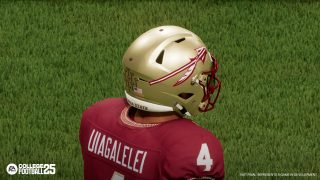
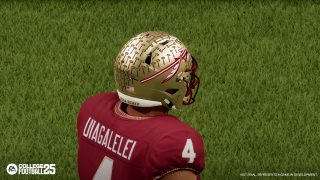
We worked with each school to understand their fill pattern to make sure that as the stickers are being applied over the course of a season they are being added in the correct pattern based on how the school applies them in real life.

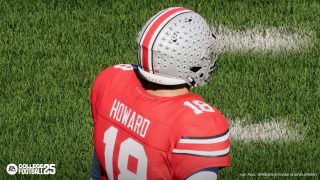
SO WHAT ELSE?
No Dynasty deep dive is complete without going through some of the utility features of the mode.
- Both Online and Offline Dynasty can go for up to 30 seasons.
- Up to 32 users can participate in a Dynasty, offline or online.
- Only one user per school.
- The Commissioner is in charge of determining the settings for the dynasty, the roster file that’s used at league creation, handles all custom conference and custom schedule changes, and is responsible for advancing the dynasty to the next week/off-season stage. No pressure.
- You can keep track of everyone’s status in the Members screen.
- Commissioner status can be transferred from the Members screen as well.
- Commissioners will have the ability to force a win in the event that a game was not able to be completed, and for those of you that like to restart a game vs the CPU that isn’t going your way, the number of times a game was started is tracked on the Scores/Schedules screen for all to see.
POST-GAME SPEECH
Congratulations if you’ve made it this far in the blog. Standing at nearly 17,000 words and 85 pages, this blog is a representation of how passionate this team is about this game. The level of dedication, commitment, and passion is what makes this team special and both of us proud to be a part of it. The entire team has had a “do whatever it takes” mentality because we know how important this game, and more specifically Dynasty mode is to you, the community.
Like we said at the top, at the end of the day, everything centered around one goal: “Satisfy the Core Community” because “This is THEIR Game”. Our entire team embraced this and tried our best to embody it each and every day. It’s been an incredible journey and we couldn’t be more excited for you to finally experience it. Thank you to the entire team and to the community for your passion, excitement, and support for this game.
With that being said, we will see you again soon for the next deep dive.
- Chad Walker, Ben Haumiller (@BenHaumiller), and the entire College Football 25 Development team
College Football 25 launches worldwide on July 19th, 2024. Pre-order the Deluxe Edition* or the EA SPORTS™ MVP Bundle** and play 3 days early. Conditions and restrictions apply. See disclaimers for details. Stay in the conversation by following us on Facebook, Twitter, Instagram, YouTube, and Answers HQ.
MVP BUNDLE
Score the MVP Bundle to get the Deluxe Editions of EA SPORTS™ College Football 25 and Madden NFL 25.

FOLLOW US @EASPORTSCollege
Sign-up for our newsletter to be the first to know about new updates.

